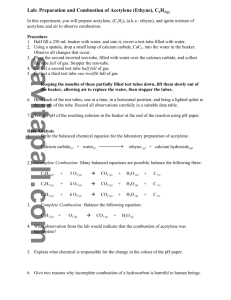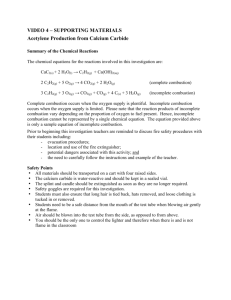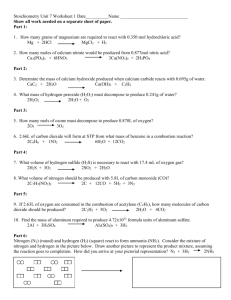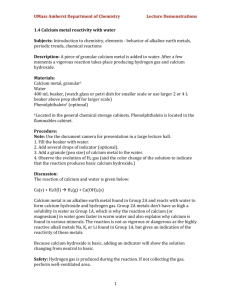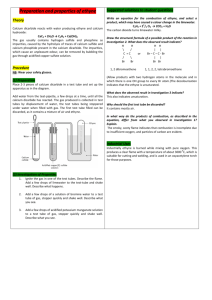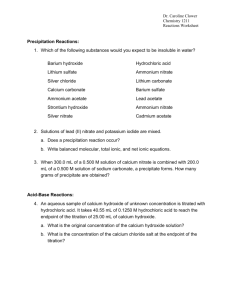Calcium Carbide
advertisement
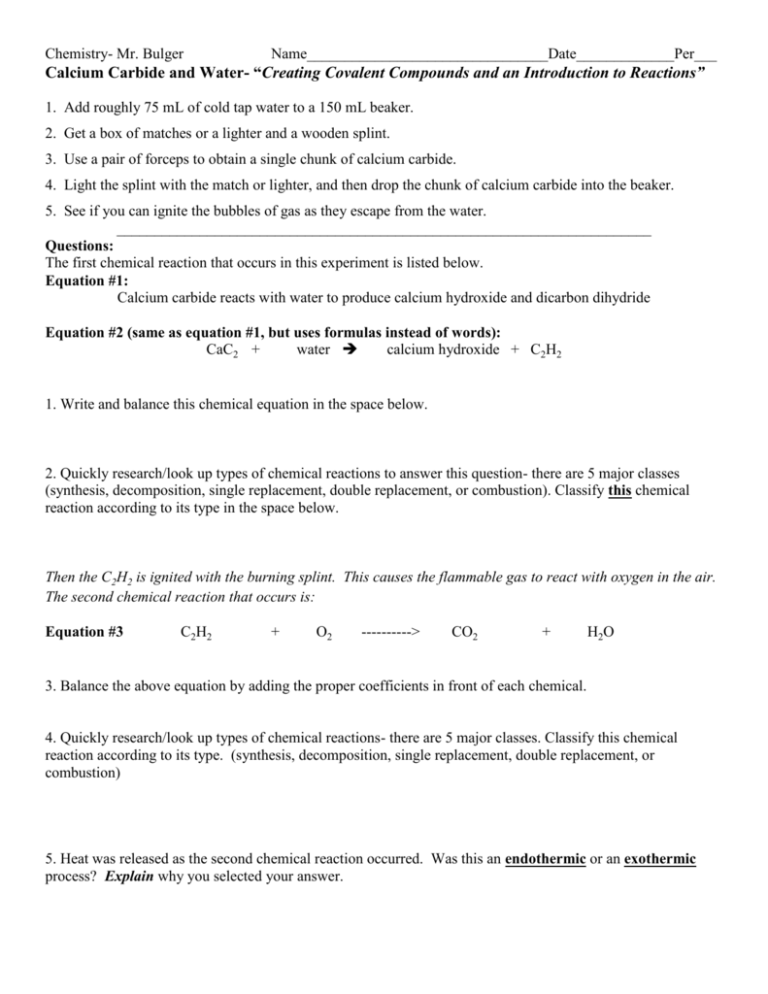
Chemistry- Mr. Bulger Name________________________________Date_____________Per___ Calcium Carbide and Water- “Creating Covalent Compounds and an Introduction to Reactions” 1. Add roughly 75 mL of cold tap water to a 150 mL beaker. 2. Get a box of matches or a lighter and a wooden splint. 3. Use a pair of forceps to obtain a single chunk of calcium carbide. 4. Light the splint with the match or lighter, and then drop the chunk of calcium carbide into the beaker. 5. See if you can ignite the bubbles of gas as they escape from the water. _______________________________________________________________________ Questions: The first chemical reaction that occurs in this experiment is listed below. Equation #1: Calcium carbide reacts with water to produce calcium hydroxide and dicarbon dihydride Equation #2 (same as equation #1, but uses formulas instead of words): CaC2 + water calcium hydroxide + C2H2 1. Write and balance this chemical equation in the space below. 2. Quickly research/look up types of chemical reactions to answer this question- there are 5 major classes (synthesis, decomposition, single replacement, double replacement, or combustion). Classify this chemical reaction according to its type in the space below. Then the C2H2 is ignited with the burning splint. This causes the flammable gas to react with oxygen in the air. The second chemical reaction that occurs is: Equation #3 C2H2 + O2 ----------> CO2 + H2O 3. Balance the above equation by adding the proper coefficients in front of each chemical. 4. Quickly research/look up types of chemical reactions- there are 5 major classes. Classify this chemical reaction according to its type. (synthesis, decomposition, single replacement, double replacement, or combustion) 5. Heat was released as the second chemical reaction occurred. Was this an endothermic or an exothermic process? Explain why you selected your answer. 6. Draw the Lewis Structures for each of the following compounds: C2H2 O2 CO2 H2O Calcium hydroxide (not covalent, but try) Experiment #5: Calcium Carbide and Water 1. Add roughly 75 mL of cold tap water to a 150 mL beaker. 2. Get a box of matches and a wooden splint. 3. Use a pair of forceps to obtain a single chunk of calcium carbide. 4. Light the wooden splint with the match, and then drop the chunk of calcium carbide into the beaker. 5. Ignite the bubbles of gas as they escape from the water. Questions: The first chemical reaction that occurs in this experiment is listed below. Equation #1: CaC2 + water ----------> calcium hydroxide + C2H2 1. Write and balance this chemical equation. 2. Classify this chemical reaction according to its type. (synthesis, decomposition, single replacement, double replacement, or combustion) Then the C2H2 is ignited with the burning splint. This causes the flammable gas to react with oxygen in the air. The second chemical reaction that occurs is: Equation #2 C2H2 + O2 ----------> CO2 + H2O 3. Balance the above equation. 4. Classify this chemical reaction according to its type. (synthesis, decomposition, single replacement, double replacement, or combustion) 5. Heat was released as the second chemical reaction occurred. Was this an endothermic or an exothermic process? Explain. 6. Draw the Lewis Structures for each of the following compounds: C2H2 CO2 O2 H2O
